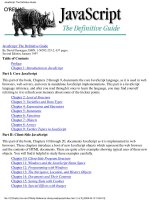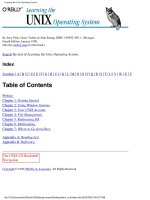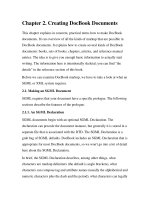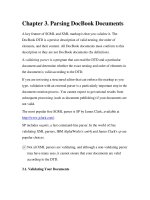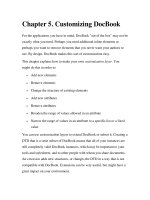o'reilly - ssh the secure shell the definitive guide
Bạn đang xem bản rút gọn của tài liệu. Xem và tải ngay bản đầy đủ của tài liệu tại đây (3.14 MB, 614 trang )
• Reviews
• Reader Reviews
• Errata
SSH, The Secure Shell: The Definitive Guide
By Daniel J. Barrett, Richard Silverman
Publisher: O'Reilly
Pub Date: January 2001
ISBN: 0-596-00011-1
Pages: 558
Copyright
Preface
Protect Your Network with SSH
Intended Audience
Reading This Book
Our Approach
Which Chapters Are for You?
Supported Platforms
Disclaimers
Conventions Used in This Book
Comments and Questions
Acknowledgments
Chapter 1. Introduction to SSH
Section 1.1. What Is SSH?
Section 1.2. What SSH Is Not
Section 1.3. The SSH Protocol
Section 1.4. Overview of SSH Features
Section 1.5. History of SSH
Section 1.6. Related Technologies
Section 1.7. Summary
Chapter 2. Basic Client Use
Section 2.1. A Running Example
Section 2.2. Remote Terminal Sessions with ssh
Section 2.3. Adding Complexity to the Example
Section 2.4. Authentication by Cryptographic Key
Section 2.5. The SSH Agent
Section 2.6. Connecting Without a Password or Passphrase
Section 2.7. Miscellaneous Clients
Section 2.8. Summary
Chapter 3. Inside SSH
Section 3.1. Overview of Features
Section 3.2. A Cryptography Primer
Section 3.3. The Architecture of an SSH System
Section 3.4. Inside SSH-1
Section 3.5. Inside SSH-2
Section 3.6. As-User Access (userfile)
Section 3.7. Randomness
Section 3.8. SSH and File Transfers (scp and sftp)
Section 3.9. Algorithms Used by SSH
Section 3.10. Threats SSH Can Counter
Section 3.11. Threats SSH Doesn't Prevent
Section 3.12. Summary
Chapter 4. Installation and Compile-Time Configuration
Section 4.1. SSH1 and SSH2
Section 4.2. F-Secure SSH Server
Section 4.3. OpenSSH
Section 4.4. Software Inventory
Section 4.5. Replacing R-Commands with SSH
Section 4.6. Summary
Chapter 5. Serverwide Configuration
Section 5.1. The Name of the Server
Section 5.2. Running the Server
Section 5.3. Server Configuration: An Overview
Section 5.4. Getting Ready: Initial Setup
Section 5.5. Letting People in: Authentication and Access Control
Section 5.6. User Logins and Accounts
Section 5.7. Subsystems
Section 5.8. History, Logging, and Debugging
Section 5.9. Compatibility Between SSH-1 and SSH-2 Servers
Section 5.10. Summary
Chapter 6. Key Management and Agents
Section 6.1. What Is an Identity?
Section 6.2. Creating an Identity
Section 6.3. SSH Agents
Section 6.4. Multiple Identities
Section 6.5. Summary
Chapter 7. Advanced Client Use
Section 7.1. How to Configure Clients
Section 7.2. Precedence
Section 7.3. Introduction to Verbose Mode
Section 7.4. Client Configuration in Depth
Section 7.5. Secure Copy with scp
Section 7.6. Summary
Chapter 8. Per-Account Server Configuration
Section 8.1. Limits of This Technique
Section 8.2. Public Key-Based Configuration
Section 8.3. Trusted-Host Access Control
Section 8.4. The User rc File
Section 8.5. Summary
Chapter 9. Port Forwarding and X Forwarding
Section 9.1. What Is Forwarding?
Section 9.2. Port Forwarding
Section 9.3. X Forwarding
Section 9.4. Forwarding Security: TCP-wrappers and libwrap
Section 9.5. Summary
Chapter 10. A Recommended Setup
Section 10.1. The Basics
Section 10.2. Compile-Time Configuration
Section 10.3. Serverwide Configuration
Section 10.4. Per-Account Configuration
Section 10.5. Key Management
Section 10.6. Client Configuration
Section 10.7. Remote Home Directories (NFS, AFS)
Section 10.8. Summary
Chapter 11. Case Studies
Section 11.1. Unattended SSH: Batch or cron Jobs
Section 11.2. FTP Forwarding
Section 11.3. Pine, IMAP, and SSH
Section 11.4. Kerberos and SSH
Section 11.5. Connecting Through a GatewayHost
Chapter 12. Troubleshooting and FAQ
Section 12.1. Debug Messages: Your First Line of Defense
Section 12.2. Problems and Solutions
Section 12.3. Other SSH Resources
Section 12.4. Reporting Bugs
Chapter 13. Overview of Other Implementations
Section 13.1. Common Features
Section 13.2. Covered Products
Section 13.3. Table of Products
Section 13.4. Other SSH-Related Products
Chapter 14. SSH1 Port by Sergey Okhapkin (Windows)
Section 14.1. Obtaining and Installing Clients
Section 14.2. Client Use
Section 14.3. Obtaining and Installing the Server
Section 14.4. Troubleshooting
Section 14.5. Summary
Chapter 15. SecureCRT (Windows)
Section 15.1. Obtaining and Installing
Section 15.2. Basic Client Use
Section 15.3. Key Management
Section 15.4. Advanced Client Use
Section 15.5. Forwarding
Section 15.6. Troubleshooting
Section 15.7. Summary
Chapter 16. F-Secure SSH Client (Windows, Macintosh)
Section 16.1. Obtaining and Installing
Section 16.2. Basic Client Use
Section 16.3. Key Management
Section 16.4. Advanced Client Use
Section 16.5. Forwarding
Section 16.6. Troubleshooting
Section 16.7. Summary
Chapter 17. NiftyTelnet SSH (Macintosh)
Section 17.1. Obtaining and Installing
Section 17.2. Basic Client Use
Section 17.3. Troubleshooting
Section 17.4. Summary
Appendix A. SSH2 Manpage for sshregex
SSHREGEX(1) SSH2
Appendix B. SSH Quick Reference
Section 2.1. Legend
Section 2.2. sshd Options
Section 2.3. sshd Keywords
Section 2.4. ssh and scp Keywords
Section 2.5. ssh Options
Section 2.6. scp Options
Section 2.7. ssh-keygen Options
Section 2.8. ssh-agent Options
Section 2.9. ssh-add Options
Section 2.10. Identity and Authorization Files
Section 2.11. Environment Variables
Colophon
Index
Book: SSH, The Secure Shell: The Definitive Guide
Copyright © 2001 O'Reilly & Associates, Inc. All rights reserved.
Printed in the United States of America.
Published by O'Reilly & Associates, Inc., 101 Morris Street, Sebastopol, CA 95472.
Nutshell Handbook, the Nutshell Handbook logo, and the O'Reilly logo are registered
trademarks of O'Reilly & Associates, Inc. Many of the designations used by manufacturers
and sellers to distinguish their products are claimed as trademarks. Where those
designations appear in this book, and O'Reilly & Associates, Inc. was aware of a trademark
claim, the designations have been printed in caps or initial caps. The association between
the image of a land snail and the topic of SSH is a trademark of O'Reilly & Associates, Inc.
While every precaution has been taken in the preparation of this book, the publisher
assumes no responsibility for errors or omissions, or for damages resulting from the use of
the information contained herein.
Book: SSH, The Secure Shell: The Definitive Guide
Preface
Privacy is a basic human right, but on today's computer networks, privacy isn't guaranteed.
Much of the data that travels on the Internet or local networks is transmitted as plain text,
and may be captured and viewed by anybody with a little technical know-how. The email
you send, the files you transmit between computers, even the passwords you type may be
readable by others. Imagine the damage that can be done if an untrusted third party-a
competitor, the CIA, your in-laws- intercepted your most sensitive communications in
transit.
Network security is big business as companies scramble to protect their information assets
behind firewalls, establish virtual private networks (VPNs), and encrypt files and
transmissions. But hidden away from all the bustle, there is a small, unassuming, yet robust
solution many big companies have missed. It's reliable, reasonably easy to use, cheap, and
available for most of today's operating systems.
It's SSH, the Secure Shell.
Book: SSH, The Secure Shell: The Definitive Guide
Section: Preface
Protect Your Network with SSH
SSH is a low-cost, software-based solution for keeping prying eyes away from the data on
a network. It doesn't solve every privacy and security problem, but it eliminates several of
them effectively. Its major features are:
● A secure, client/server protocol for encrypting and transmitting data over a network
● Authentication (recognition) of users by password, host, or public key, plus
optional integration with other popular authentication systems, including Kerberos,
SecurID, PGP, TIS Gauntlet, and PAM
● The ability to add security to insecure network applications such as Telnet, FTP,
and many other TCP/IP-based programs and protocols
● Almost complete transparency to the end user
● Implementations for most operating systems
Book: SSH, The Secure Shell: The Definitive Guide
Section: Preface
Intended Audience
We've written this book for system administrators and technically minded users. Some
chapters are suitable for a wide audience, while others are thoroughly technical and
intended for computer and networking professionals.
End-User Audience
Do you have two or more computer accounts on different machines? SSH lets you connect
one to another with a high degree of security. You can copy files between accounts,
remotely log into one account from the other, or execute remote commands, all with the
confidence that nobody can intercept your username, password, or data in transit.
Do you connect from a personal computer to an Internet service provider (ISP)? In
particular, do you connect to a Unix shell account at your ISP? If so, SSH can make this
connection significantly more secure. An increasing number of ISPs are running SSH
servers for their users. In case your ISP doesn't, we'll show you how to run a server
yourself.
Do you develop software? Are you creating distributed applications that must communicate
over a network securely? Then don't reinvent the wheel: use SSH to encrypt the
connections. It's a solid technology that may reduce your development time.
Even if you have only a single computer account, as long as it's connected to a network,
SSH can still be useful. For example, if you've ever wanted to let other people use your
account, such as family members or employees, but didn't want to give them unlimited use,
SSH can provide a carefully controlled, limited access channel into your account.
Prerequisites
We assume you are familiar with computers and networking as found in any modern
business office or home system with an Internet connection. Ideally, you are familiar with
the Telnet and FTP applications. If you are a Unix user, you should be familiar with the
programs rsh, rlogin, and rcp, and with the basics of writing shell scripts.
System-Administrator Audience
If you're a Unix system administrator, you probably know that the Berkeley r-commands
(rsh, rcp, rlogin, rexec, etc.) are inherently insecure. SSH provides secure, drop-in
replacements, eliminates .rhosts and hosts.equiv files, and can authenticate users by
cryptographic key. SSH also can increase the security of other TCP/IP-based applications
on your system by transparently "tunneling" them through SSH encrypted connections.
You will love SSH.
Prerequisites
In addition to the end-user prerequisites in the previous section, you should be familiar
with Unix accounts and groups, networking concepts such as TCP/IP and packets, and
basic encryption techniques.
Book: SSH, The Secure Shell: The Definitive Guide
Section: Preface
Reading This Book
This book is roughly divided into three parts. The first three chapters are a general
introduction to SSH, first at a high level for all readers (Chapter 1 and Chapter 2), and then
in detail for technical readers (Chapter 3).
The next nine chapters cover SSH for Unix. The first two (Chapter 4 and Chapter 5) cover
SSH installation and serverwide configuration for system administrators. The next four
(Chapter 6-Chapter 9) cover advanced topics for end users, including key management,
client configuration, per-account server configuration, and forwarding. We complete the
Unix sequence with our recommended setup (Chapter 10), some detailed case studies
(Chapter 11), and troubleshooting tips (Chapter 12).
The remaining chapters cover SSH products for Windows and the Macintosh, plus brief
overviews of implementations for other platforms (Chapter 13).
Each section in the book is numbered, and we provide cross-references throughout the text.
If further details are found in Section 7.1.3.2, we use the notation [Section 7.1.3.2] to
indicate it.
Book: SSH, The Secure Shell: The Definitive Guide
Section: Preface
Our Approach
This book is organized by concept rather than syntax. We begin with an overview and
progressively lead you deeper into the functionality of SSH. So we might introduce a topic
in Chapter 1, show its basic use in Chapter 2, and reveal advanced uses in Chapter 7. If you
would prefer the whole story at once, Appendix B presents all commands and their options
in one location.
We focus strongly on three levels of server configuration, which we call compile-time,
serverwide, and per-account configuration. Compile-time configuration (Chapter 4) means
selecting appropriate options when you build the SSH clients and servers. serverwide
configuration (Chapter 5) applies when the SSH server is run and is generally done by
system administrators, while per-account configuration (Chapter 8) can be done any time
by end users. It's vitally important for system administrators to understand the relationships
and differences among these three levels. Otherwise, SSH may seem like a morass of
random behaviors.
Although the bulk of material focuses on Unix implementations of SSH, you don't have to
be a Unix user to understand it. Fans of Windows and Macintosh may stick to the later
chapters devoted to their platforms, but a lot of the meaty details are in the Unix chapters
so we recommend reading them, at least for reference.
Book: SSH, The Secure Shell: The Definitive Guide
Section: Preface
Which Chapters Are for You?
We propose several "tracks" for readers with different interests and skills:
System administrators
Chapter 3-Chapter 5 and Chapter 10 are the most important for understanding SSH
and how to build and configure servers. However, as the administrator of a security
product, you should read the whole book.
Unix users (not system administrators)
Chapter 1-Chapter 2 provide an overview, and Chapter 6 through Chapter 9 discuss
SSH clients in depth.
Windows end users
Read Chapter 1, Chapter 2, and Chapter 13 through Chapter 16, for starters, and
then others as your interests guide you.
Macintosh end users
Read Chapter 1, Chapter 2, Chapter 13, Chapter 16, and Chapter 17, for starters,
and then others as your interests guide you.
Users of other computer platforms
Read Chapter 1, Chapter 2, and Chapter 13, for starters, and then others as your
interests guide you.
Even if you are experienced with SSH, you will likely find value in Chapter 3-Chapter 12.
We cover significant details the Unix manpages leave unclear or unmentioned, including
major concepts, compile-time flags, server configuration, and forwarding.
Book: SSH, The Secure Shell: The Definitive Guide
Section: Preface
Supported Platforms
This book covers Unix, Windows, and Macintosh implementations of SSH. Products are
also available for the Amiga, BeOs, Java, OS/2, Palm Pilot, VMS, and Windows CE, and
although we don't cover them, their principles are the same.
This book is current for the following Unix SSH versions:
SSH1 1.2.30
F-Secure SSH1 1.3.7
OpenSSH 2.2.0
SSH Secure Shell (a.k.a. SSH2) 2.3.0
F-Secure SSH2 2.0.13
The F-Secure products for Unix differ little from SSH1 and SSH2, so we won't discuss
them separately except for unique features. See Appendix B for a summary of the
differences.
Version information for non-Unix products is found in their respective chapters.
Book: SSH, The Secure Shell: The Definitive Guide
Section: Preface
Disclaimers
We identify some program features as "undocumented." This means the feature isn't
mentioned in the official documentation but works in the current release and/or is clear
from the program source code. Undocumented features may not be officially supported by
the software authors and can disappear in later releases.
Book: SSH, The Secure Shell: The Definitive Guide
Section: Preface
Conventions Used in This Book
This book uses the following typographic conventions:
Constant width
For configuration files, things that can be found in configuration files (such as
keywords and configuration file options), source code, and interactive terminal
sessions.
Constant width italic
For replaceable parameters on command lines or within configuration files.
Italic
For filenames, URLs, hostnames, command names, command-line options, and
new terms whre they are defined.
A
K
In figures, the object labeled A has been secured using a cryptographic key labled
K. "Secured" means encrypted, signed, or some more complex relationship,
depending on the context. If A is secured using multiple keys (say K and L), they
will be listed in the subscript, separated by commas: A
K, L
This icon designates a note, which is an important aside to the
nearby text.
This icon designates a warning relating to the nearby text.
Book: SSH, The Secure Shell: The Definitive Guide
Section: Preface
Comments and Questions
The information in this book has been tested and verified, but you may find that features
have changed (or even find mistakes!). You can send any errors you find, as well as
suggestions for future editions, to:
O'Reilly & Associates, Inc.
1005 Gravenstein Highway North
Sebastopol, CA 95472
(800) 998-9938 (in the United States or Canada)
(707) 829-0515 (international/local)
(707) 829-0104 (fax)
There is a web page for this book, which lists errata, examples, or any additional
information. You can access this page at:
/>To comment or ask technical questions about this book, send email to:
For more information about books, conferences, software, Resource Centers, and the
O'Reilly Network, see the O'Reilly web site at:
/>Book: SSH, The Secure Shell: The Definitive Guide
Section: Preface
Acknowledgments
First and foremost, we'd like to thank O'Reilly & Associates for the opportunity to write
this book, especially our editor, Mike Loukides, who let us stretch the schedule to cover
advanced topics in depth. We thank Frank Willison for believing in our idea, Christien
Shangraw for administrative excellence and for heroically performing the first typesetting
pass, Mike Sierra for tools and advice, and Rob Romano for turning our hasty sketches into
polished illustrations.
We thank our excellent technical review team for their thorough reading and insightful
comments: Anne Carasik, Markus Friedl, Joseph Galbraith, Sergey Okhapkin, Jari Ollikka,
Niels Provos, Theo de Raadt, Jim Sheafer, Drew Simonis, Mike Smith, and Dug Song.
Big thanks to the vendors and developers of SSH products who provided us with free
copies and answered our questions: Tatu Ylönen, Anne Carasik, and Arlinda Sipilä (SSH
Communication Security, Ltd.); Sami Sumkin, Heikki Nousiainen, Petri Nyman, Hannu
Eloranta, and Alexander Sayer (F-Secure Corporation); Dan Rask (Van Dyke
Technologies, Inc.); Gordon Chaffee (Windows SSH port); Ian Goldberg (Top Gun SSH);
Douglas Mak (FiSSH); Jonas Walldén (NiftyTelnet SSH); and Stephen Pendleton (sshCE).
SSH Communication Security also gave us permission to include the sshregex manpage
(Appendix A) and the sshdebug.h error codes (Table 5-6).
We thank Rob Figenbaum, James Mathiesen, and J.D. Paul for tips and inspirations
incorporated into the text; and Chuck Bogorad, Ben Gould, David Primmer, and Brandon
Zehm for their web pages about SSH on NT. Richard Silverman would like to thank his co-
workers at the company formerly known as, especially Michelle Madelien, for being very
flexible and accommodating with his erratic hours and behavior while working on this
tome. He would also like to thank Deborah Kaplan for her judicious and inspired
application of the LART. Lastly, we thank the many contributors to comp.security.ssh on
Usenet, for asking good questions that improved the book, especially Chapter 12.
Book: SSH, The Secure Shell: The Definitive Guide
Chapter 1. Introduction to SSH
Many people today have multiple computer accounts. If you're a reasonably savvy user,
you might have a personal account with an Internet service provider (ISP), a work account
on your employer's local network, and one or more PCs at home. You might also have
permission to use other accounts owned by family members or friends.
If you have multiple accounts, it's natural to want to make connections between them. For
instance, you might want to copy files between computers over a network, log into one
account remotely from another, or transmit commands to a remote computer for execution.
Various programs exist for these purposes, such as ftp and rcp for file transfers, telnet and
rlogin for remote logins, and rsh for remote execution of commands.
Unfortunately, many of these network-related programs have a fundamental problem: they
lack security. If you transmit a sensitive file via the Internet, an intruder can potentially
intercept and read the data. Even worse, if you log onto another computer remotely using a
program such as telnet, your username and password can be intercepted as they travel over
the network. Yikes!
How can these serious problems be prevented? You can use an encryption program to
scramble your data into a secret code nobody else can read. You can install a firewall, a
device that shields portions of a computer network from intruders. Or you can use a wide
range of other solutions, alone or combined, with varying complexity and cost.
Book: SSH, The Secure Shell: The Definitive Guide
Section: Chapter 1. Introduction to SSH
1.1 What Is SSH?
SSH, the Secure Shell, is a popular, powerful, software-based approach to network security.
[1]
Whenever data is sent by a computer to the network, SSH automatically encrypts it.
When the data reaches its intended recipient, SSH automatically decrypts (unscrambles) it.
The result is transparent encryption: users can work normally, unaware that their
communications are safely encrypted on the network. In addition, SSH uses modern, secure
encryption algorithms and is effective enough to be found within mission-critical
applications at major corporations.
SSH has a client/server architecture, as shown in Figure 1-1. An SSH server program,
typically installed and run by a system administrator, accepts or rejects incoming
connections to its host computer. Users then run SSH client programs, typically on other
computers, to make requests of the SSH server, such as "Please log me in," "Please send me
a file," or "Please execute this command." All communications between clients and servers
are securely encrypted and protected from modification.
Figure 1.1. SSH architecture
Our description is simplified but should give you a general idea of what SSH does. We'll go
into depth later. For now, just remember that SSH clients communicate with SSH servers
over encrypted network connections.
An SSH-based product might include clients, servers, or both. Unix products generally
contain both clients and servers; those on other platforms are usually just clients, though
Windows-based servers are beginning to appear.
If you're a Unix user, think of SSH as a secure form of the Unix r-commands: rsh (remote
shell), rlogin (remote login), and rcp (remote copy). In fact, the original SSH for Unix
includes the similarly named commands ssh, scp, and slogin as secure, drop-in replacements
for the r-commands. Yes, you can finally get rid of those insecure .rhosts and hosts.equiv
files! (Though SSH can work with them as well, if you like.) If you're still using the r-
commands, switch to SSH immediately: the learning curve is small, and security is far
better.
[1]
"SSH" is pronounced by spelling it aloud: S-S-H. You might find the name "Secure Shell" a
little puzzling, because it is not, in fact, a shell at all. The name was coined from the existing rsh
utility, a ubiquitous Unix program that also provides remote logins but is very insecure.
Book: SSH, The Secure Shell: The Definitive Guide
Section: Chapter 1. Introduction to SSH
1.2 What SSH Is Not
Although SSH stands for Secure Shell, it is not a true shell in the sense of the Unix Bourne
shell and C shell. It is not a command interpreter, nor does it provide wildcard expansion,
command history, and so forth. Rather, SSH creates a channel for running a shell on a
remote computer, in the manner of the Unix rsh command, but with end-to-end encryption
between the local and remote computer.
SSH is also not a complete security solution-but then, nothing is. It won't protect computers
from active break-in attempts or denial-of-service attacks, and it won't eliminate other
hazards such as viruses, Trojan horses, and coffee spills. It does, however, provide robust
and user-friendly encryption and authentication.
Book: SSH, The Secure Shell: The Definitive Guide
Section: Chapter 1. Introduction to SSH
1.3 The SSH Protocol
SSH is a protocol, not a product. It is a specification of how to conduct secure
communication over a network.
[2]
The SSH protocol covers authentication, encryption, and the integrity of data transmitted
over a network, as shown in Figure 1-2. Let's define these terms:
Authentication
Reliably determines someone's identity. If you try to log into an account on a
remote computer, SSH asks for digital proof of your identity. If you pass the test,
you may log in; otherwise SSH rejects the connection.
Encryption
Scrambles data so it is unintelligible except to the intended recipients. This protects
your data as it passes over the network.
Integrity
Guarantees the data traveling over the network arrives unaltered. If a third party
captures and modifies your data in transit, SSH detects this fact.
Figure 1.2. Authentication, encryption, and integrity
In short, SSH makes network connections between computers, with strong guarantees that
the parties on both ends of the connection are genuine. It also ensures that any data passing
over these connections arrives unmodified and unread by eavesdroppers.
1.3.1 Protocols, Products, Clients, and Confusion
SSH-based products-i.e., products that implement the SSH protocol-exist for many flavors
of Unix, Windows, Macintosh, and other operating systems. Both freely distributable and
commercial products are available. [Section 13.3]
The first SSH product, created by Tatu Ylönen for Unix, was simply called "SSH." This
causes confusion because SSH is also the name of the protocol. Some people call Ylönen's
software "Unix SSH," but other Unix-based implementations are now available so the
name is unsatisfactory. In this book, we use more precise terminology to refer to protocols,
products, and programs, summarized in Sidebar "Terminology: SSH Protocols and
Products", In short:
● Protocols are denoted with dashes: SSH-1, SSH-2.
● Products are denoted in uppercase, without dashes: SSH1, SSH2.
● Client programs are in lowercase: ssh, ssh1, ssh2, etc.

